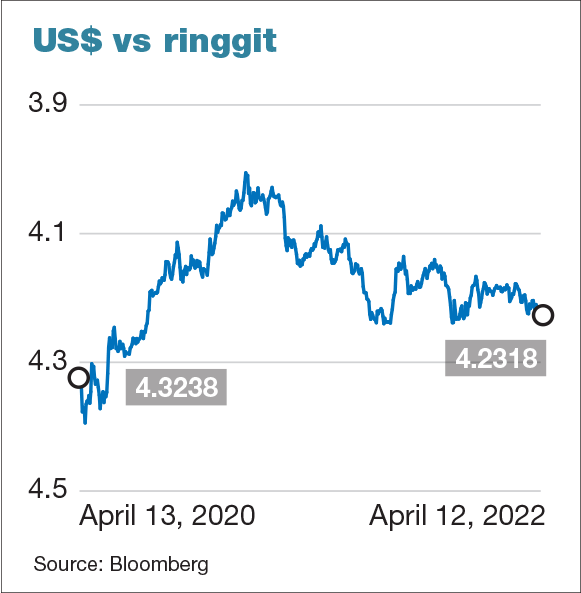
KUALA LUMPUR (April 12): The Malaysian ringgit (MYR) weakened against the US dollar (USD) to 4.2415 on early Tuesday (April 12) — the lowest level since July 29, 2020 — mainly due to rising US yields and fears of a slowdown in the Chinese economy.
The MYR fluctuated between 4.2310 and 4.2415 on Tuesday, according to Bloomberg, and at the time of writing, stood at 4.2318, a decline of 0.03% from Monday.
OCBC Bank foreign exchange (FX) Strategist Terence Wu said the ringgit has been undermined by rising back-end US treasury (UST) yields and shaky global risk sentiments.
“Higher back-end UST yields have reduced the attractiveness of emerging market Asian bonds and assets, potentially leading to a pull-out of portfolio flows. Malaysia is not immune to this dynamic,” he told theedgemarkets.com.
According to him, since March, the 10-year Malaysian government securities (MGS)-UST yield differentials have compressed around 50 basis points (bps) and 70 bps in real and nominal terms respectively.
“This could have weighed on the MYR. More recently, the extended run in the UST yields has further impacted other asset classes, such as equities, and led to a more generalised risk-off sentiment. This adds another layer to the MYR negativity,” he said.
Nevertheless, he noted that MYR will not be the worst hit among Southeast Asian countries.
“The crude oil and commodity complex have seen some retracement, but remain at relatively elevated levels. This should ultimately provide some support for the MYR as a net commodity exporter."
He projected the MYR would strengthen to 4.2186 against the greenback by June, 4.1857 (September), 4.1486 (December), and 4.1115 (March 2023).
Meanwhile, OANDA Asia Pacific senior market analyst Jeffrey Halley told theedgemarkets.com that the MYR, like other Asian currencies in general, is weakening because US yields are rising, widening rate differentials.
Fears of slowing growth in China spilling over into Asia as a whole, and recent fall in oil prices, have also added pressure to the MYR, he added.
Thus, he expects the local unit to fall back toward 4.40 over the next quarter, mostly driven by a hawkish Federal Reserve aggressively hiking interest rates.
SPI Asset Management Managing Partner Stephen Innes told theedgemarkets.com the surge in US yields this week is supporting the USD as the market has veered into “don't fight the Fed (Federal Reserve) mode” when it comes to Asia FX.
He also said Asia FX especially the MYR was affected by the sentiment in China due to its close trading ties with China's consumer basket.
“Via China, the start of the week gave us more lockdown and no stimulus — many had hoped for a reserve requirement ratio (RRR) cut. Shanghai has evolved from a partial lockdown due to end on April 5 to one of unprecedented scale and no guided end date,” he explained.
However, he opined that China could be the key to the MYR recovery as he does not believe the People’s Bank of China (PBoC) will sit idle and watch the economy flop without coming to the market rescue.
Besides, he thinks the market will see a gradual pullback on China's zero covid policy as it's becoming a point of contention for the mainland public.
On the oil price side, he expects Brent crude oil prices to remain above US$90 per barrel through 2022, which should come back to support the MYR, especially when China's economy picks up.
“So if the stars align, PBoC rate cut, pull back on China zero covid, high oil prices through 2022, peak Fed/consumer price index (CPI), I think the USDMYR could trade at 4.20 by the second quarter and 4.15 by year-end,” he said.

